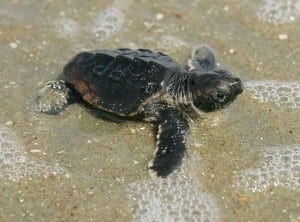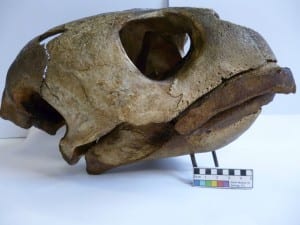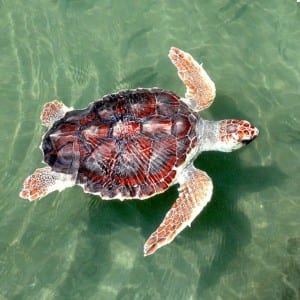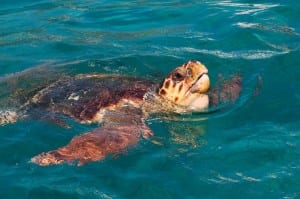Specimen of the Week: Week 159
By Dean W Veall, on 27 October 2014
 Dean Veall here. My turn on SoTW has come round again and this week I have chosen a specimen that belongs to the group that is a favourite of museums to hang from ceilings, in fact one of my first museum memories was as a young curly haired child wandering around Amgueddfa Cymru-National Museums Wales (AC-NMW), National Museum Cardiff, and encountering one dangling from the ceiling. There’s a hint of my choice there, museums love to suspend things from the ceiling and the top favourites tend to be whales, seals and birds, (we like to break the mould here at the GMZ and have instead chosen to suspend our seal from the balcony). My specimen this week also comes from a group of animals that date back a phenomenal 220 million years. Some individuals of the group that this week’s specimen belongs to are the longest lived animals on the planet. You should be warned this week’s blog contains some cute images of young versions of this species. This week’s specimen is……..
Dean Veall here. My turn on SoTW has come round again and this week I have chosen a specimen that belongs to the group that is a favourite of museums to hang from ceilings, in fact one of my first museum memories was as a young curly haired child wandering around Amgueddfa Cymru-National Museums Wales (AC-NMW), National Museum Cardiff, and encountering one dangling from the ceiling. There’s a hint of my choice there, museums love to suspend things from the ceiling and the top favourites tend to be whales, seals and birds, (we like to break the mould here at the GMZ and have instead chosen to suspend our seal from the balcony). My specimen this week also comes from a group of animals that date back a phenomenal 220 million years. Some individuals of the group that this week’s specimen belongs to are the longest lived animals on the planet. You should be warned this week’s blog contains some cute images of young versions of this species. This week’s specimen is……..
**The loggerhead turtle (Caretta caretta) skull**
1). The battle begins at hatching
Loggerheads like many other species of turtle and giant tortoise are long lived, with a lifespan of between 40 and 70 years. As a result of this longevity females will reach sexual maturity at some point between the ages of 15 and 30. When fully grown the loggerhead turtle will usually reach around a metre in length but some individuals found to be almost two metres long and weighing a whopping 450 kgs. An amazing feat considering that upon hatching the average loggerhead will only measure 4.6cm. Life for a hatchling loggerhead is harsh, there is no parental care in this species and upon hatching each individual must fend for itself. Females will come ashore to lay up to four clutches at intervals of 20 days of around 115 eggs each season before becoming quiescent for some three years. And who can you blame her? 460 eggs in one season?! After 80 days incubation, hatchlings must run the gauntlet in a mad dash to get down to the water and out to sea as quickly as possible each makes a great meal for anything from gulls to bears, from snakes to pigs and even a crab will predate a young loggerhead as it makes its first journey to the ocean.
2). Temperature is key
The sex of a loggerhead turtle is determined by the temperature of the nest, this is a similar mechanism exhibited by other reptiles such as snakes and crocodiles. In an experiment in the 1970’s that looked more closely at this species to pin point the temperatures that underlies sex determination researchers took a clutch of eggs and divided them up into groups incubating them at constant temperatures ranging from 26 degrees to 34 degrees Celsius . Using this method they discovered that to produce a male loggerhead the ideal nest temperature is below 30 degrees and to produce a female it is above 30 degrees, at exactly 30 degrees Celsius you get an equal ratio of male to females hatching. [1]
3). The ‘Lost Years’
Loggerhead reproduction and early years life history is fairly well researched and documented as evident from the above study looking at sex determination, however, our knowledge of adult loggerheads and other turtles becomes less concrete when they leave the nest disperse and on the sea currents. Marine biologists have referred to this period as the ‘Lost Years’ as they are limited in their methods to monitor them once they are out at sea. A recent study has shed some light on the first few hours of a hatching’s life using novel nano-tagging techniques that is starting to fill in the gaps of our knowledge. Acoustic nano-tags measuring 12mm in length were fitted to 11 hatchlings that emitted pings and using hydrophones researchers followed their progress for eight hours of their first day before the tags fell off. They discovered these young turtles swimming like crazy for up to a phenomenal 15 km at a rapid speed of 60m a minute. As well as field studies the research involved lab work, where hatchling’s swimming activity was monitored in a swimming pool over a longer period of time and they were harnessed to prevent them hitting the sides of the tank. The sample of hatchlings were taken from the Eastern side of the Atlantic from the Cape Verde and when compared with other similar experiments from the Western Atlantic showed they swam less frenetically for shorter amount of time. This, the researchers suggest, is the effect of local oceanic conditions driving the evolution of innate swimming behaviours, hatchlings in the Western Atlantic emerge knowing they have to swim a lot to get to the sea currents whereas the Eastern Atlantic hatchlings don’t have to swim as much. [2]

Image taken by Hillebrand Steve, U.S. Fish and Wildlife Service obtained from http://commons.wikimedia.org
4). A beaky grin
Loggerhead turtles are carnivorous predating heavily on invertebrates such jellyfish and squid when migrating the massive distances this species is known to do, some travelling as much as 11,000 km in a single journey. One feature of this specimen is the horny beak, the darker edges around the lips of the skull. The hard horny beak helps this species prey upon harder shelled invertebrates dwelling at the bottom of the ocean with adults observed feeding on crustaceans, horseshoe crabs and bivalves. For much of the time this specimen was in the Museum it was missing its beak, it wasn’t until recently that a volunteer who was working through our collections discovered a beak without a skull. In a prince charming/Cinderella fashion our curator Mark slipped the beak on the skull and reunited the specimen for the first time in many many years, giving the specimen the charming beaky grin it has today.
5). Fishing line threats
As a species the loggerhead turtle is classified as ‘Endangered’ with the species “facing a very high risk of extinction in the wild in the near future” according the International Union for the Conservation of Nature’s Red List. This specimen can be found in our Extinct and Endangered case for just that reason sitting alongside other specimens such as the thylacine and the quagga. The main threats to this species is incidental capture in fishing nets as this species is often found in association with commercially attractive fish stocks. The specimen I mentioned in the introduction on display in AC-NMW National Museum Cardiff, , although not a loggerhead but in fact a leatherback, was found drowned off the mid-wales coast after being caught in fishing nets, demonstrating it is a threat that is not confined to just the loggerhead. An increasingly important threat to loggerheads is marine debris, mostly plastic waste such as cups, balloons and plastic bags. Recent studies have shown that after investigating the gut contents of individuals found dead along the coast of the Adriatic Sea marine debris made up some 35% of their gut contents which could possibly have had the effect of intestinal blockage as well as build-up of toxins in internal tissues having a sub-lethal effect on individuals. [3]
References
[1] Yntema, C. L., and Nicholas Mrosovsky. Sexual differentiation in hatchling loggerheads (Caretta caretta) incubated at different controlled temperatures. Herpetologica (1980): 33-36.
[2] Rebecca Scott, Arne Biastoch, Christian Roder, Victor A. Stiebens, and Christophe Eizaguirre, Nano-tags for neonates and ocean-mediated swimming behaviours linked to rapid dispersal of hatchling sea turtles Proc R Soc B 2014 281: 20141209
[3] Bojan Lazar, Romana Gračan, Ingestion of marine debris by loggerhead sea turtles, Caretta caretta, in the Adriatic Sea, Marine Pollution Bulletin, Volume 62, Issue 1, January 2011, Pages 43-47
Dean Veall is Learning and Access Officer at the Grant Museum of Zoology
One Response to “Specimen of the Week: Week 159”
- 1
 Close
Close





[…] turtle are endangered and protected by international law, and you can find out more about the loggerhead and green turtles in our previous […]